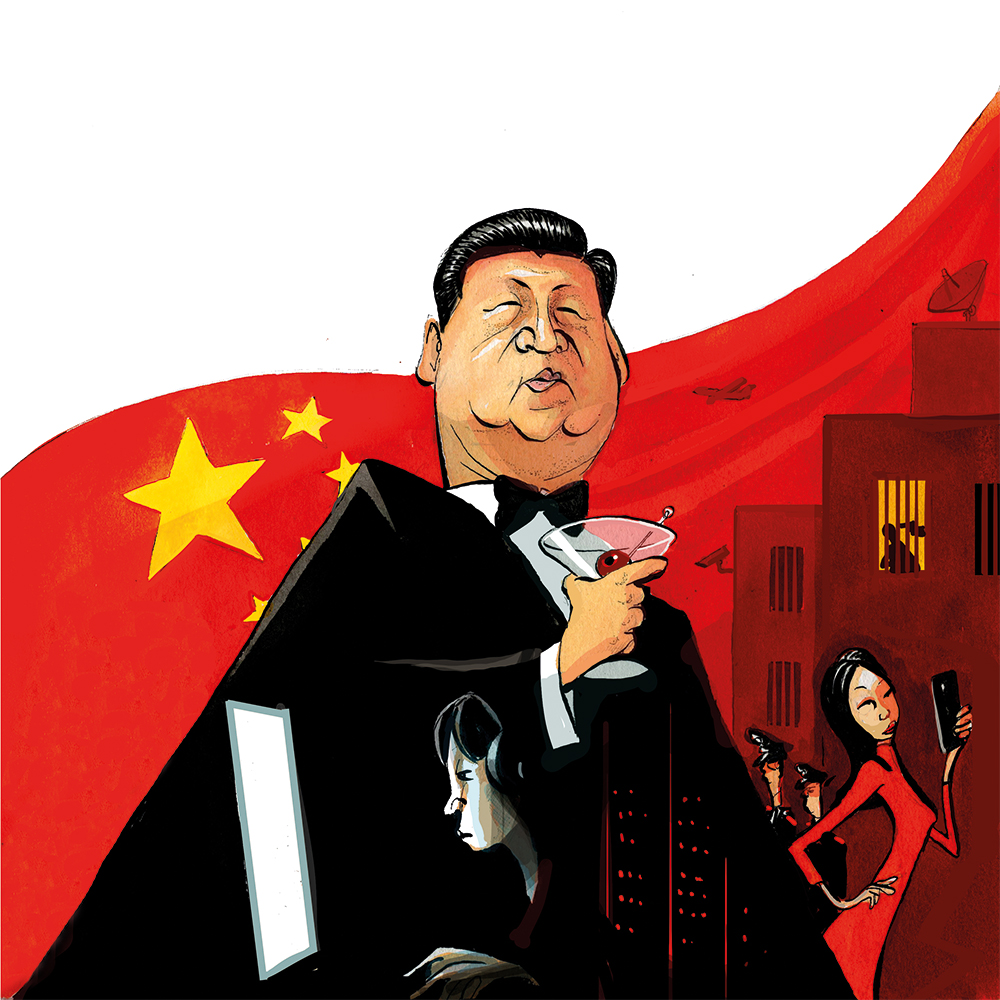Competition between the US and China will shape the 21st century, but have the Chinese already leap-frogged the Americans? It looks as if they might have done. Since China opened itself up to trade and market economics under Deng Xiaoping almost 50 years ago, it has been furiously chasing the US in terms of economic and technological development – and it’s been catching up, fast. We can prove just how fast by measuring its innovation and output per capita.
The US has about a quarter of China’s population, so if both countries were at a similar level of economic and technological development, one would expect China to produce roughly four times the number of scientific breakthroughs as America, four times the number of physicists and AI engineers and so on. Within any given category, of course, a particular country might punch above its weight or lag behind. But overall, you expect to see innovation in proportion to the population.
So because it’s four times the size, if China has reached even half the overall level of development of the US, it should have about twice the impact on the world that the US does. And if it were ever to reach full parity, it could eclipse the US in the same way the US eclipses, say, the UK, which has a fifth as many people.
After analyzing and comparing the US and China on a number of key indicators, I would suggest that the magnitude of China’s economic and technological capacity is at least twice that of the US. Furthermore, the rate of advance in most areas seems to be significantly faster than in the US. The critical question is whether China’s aggregate functional economy – the scale of goods, infrastructure, science and advanced production – has already surpassed America’s. Evidence increasingly indicates that it has.
China builds the globe’s largest container ships, supplying not only its own fleet but the world’s
The trouble for economists trying to estimate China’s advance is that GDP comparisons can be misleading. Nominal GDP, measured in dollars, simply multiplies local prices by quantities. Local Chinese prices are converted to dollars using the yuan exchange rate, which is managed by the government, so the relationship between price and functional value may be distorted.
Also, the costs for US services, housing, and medical care may be inflated relative to functional value, exaggerating American output in GDP figures. For example, MRI scans average $1,100 to $1,500 in the US, versus $150 to $250 in Japan or China.
Purchasing power parity (PPP) calculations attempt to adjust for price differences. For example, World Bank PPP computations are performed by the international comparison program (ICP), which is a global statistical initiative. But even GDP calculated by PPP undervalues China because the international comparison program’s baskets mis-price key goods. Economist Rafael Guthmann has shown that China’s 2021 ICP entries treat a Chinese-made car, apartment, or kilowatt-hour as cheaper than equivalents in Mexico – an obvious inconsistency. Correcting those errors doubles China’s PPP consumption, lifting its real scale to roughly twice the US.
A functional comparison – looking at physical and technological outputs – reinforces this result. Electricity is the most neutral metric of a civilization’s real work budget. In 2023, China generated 9,300 terawatt-hours (TWh) of power, versus the US’s ~4,100 TWh – a 2.2× multiple. Every kilowatt-hour ultimately feeds industrial equipment, transport, data centers and homes; it measures the energy throughput of the economy itself.
China produced 1.02 billion tons of crude steel in 2024, compared with the US’s 81 million tons – 12.6 times as much. In cement the gap is even wider, over 20 times, reflecting the enormous infrastructure buildup of roads, high-speed rail and urban housing. No modern economy can function without these basic industrial materials; China’s dominance in them represents a decisive shift in the global balance of productive capacity.
Vehicle output tells a similar story. According to automotive industry data, China built 31 million cars and trucks in 2024, compared with 10.5 million in the United States. In shipbuilding, the disparity is staggering: Chinese yards account for more than 55 percent of global completions, while the US share is less than 0.1 percent. China builds the globe’s largest container ships, LNG carriers and naval hulls, supplying not only its own fleet but the world’s.
Guthmann’s reconciliation of PPP measures indicates Chinese industrial value-added of about $12 trillion versus the US’s $4 trillion – a 3× ratio. On his broader 23-item physical-volume basket, China’s manufacturing output exceeds America’s by over four times. These figures align with other “functional” indicators like steel and electricity: China produces several times as much physical stuff, even if PPP GDP shows only a narrow lead.
By late 2024, China had more than one billion 5G connections versus roughly 260 million devices in service in the US – a fourfold advantage. China’s cellular backbone supports the world’s densest network of IoT sensors, autonomous-vehicle pilots and AI-driven industrial automation. American telecom carriers lag in both tower density and spectrum deployment.
Parcel volumes reveal another side of the story. China’s express-delivery system handled about 150 billion packages last year, compared with the United States’s 28 billion. That 5× difference quantifies the real throughput of its digital economy – the scale at which software, payments, warehouses and last-mile logistics operate.
Domestic competition among giants such as Alibaba, JD.com and Meituan has produced one of the world’s most efficient logistics networks, with same-day delivery available to hundreds of millions of people. This ecosystem acts as both consumer convenience and strategic infrastructure: it trains AI forecasting models, robotics and autonomous-delivery systems at national scale. In terms of food, China now consumes about 100 million tons of meat annually, roughly twice the US total, although per-capita intake is still lower. Aggregate calorie and protein consumption – a proxy for middle-class living standards – has already exceeded America’s in absolute terms.
Power consumption per capita in urban areas such as Guangdong or Jiangsu rivals that of western Europe, while internet penetration exceeds 75 percent nationwide. Chinese universities graduate 1.5 million engineers per year, nearly ten times the American number. In frontier disciplines – AI, materials, quantum and power electronics – Chinese publication counts already exceed those of the US both in volume and in high-impact citation share.
As I’ve written here before, China now trains more PhDs in physics, chemistry and engineering than the US, and that gap widens each year. As a result, China’s aggregate scientific man-years of effort are becoming a structural advantage that no short-term policy can reverse.
While China faces a future demographic challenge due to low birth rates, the cohorts that will enter the workforce over the next 20 years are already born. During that period, the total workforce will decline by about 10 percent while the average level of education will rise considerably. Young people entering the workforce are several times more likely to have had post-secondary education than the group that is retiring.
Even if China fails to solve its demographic problem over the next 20 years, it may be saved by automation: China installs more industrial robots each year than the rest of the world combined, and most of those robots are now made domestically. The density of robots per 10,000 workers is about 1.5 times higher in China than in the US.
China’s growing self-sufficiency means its growth trajectory no longer depends on western supply chains
The first derivative – the rate of advance – now also favors China. Chinese firms operate the world’s largest computer clusters outside the US; Chinese AI models occupy many of the top spots and only trail the top US labs slightly. In renewable energy, China produces 80 percent of global solar panels, 70 percent of lithium-ion batteries and 60 percent of EVs. In quantum communications and hypersonics, systems sometimes exceed their US counterparts in capability.
If China’s functional output across industry, logistics and science is already roughly twice that of America’s, the strategic momentum of the 21st century may well resemble the 19th-century transition from Britain to the United States.
China’s domestic market, industrial ecosystem and STEM labor pool now form the largest integrated production base in human history. Its growing self-sufficiency in energy (nuclear, solar, coal), computing hardware and industrial materials means its growth trajectory no longer depends on western supply chains. One can envision a future in which China’s imports are predominantly raw materials, and its exports are high-value-added technological goods.
So by the most concrete metrics – watts, tons, transistors, kilometers, patents and engineers – China has already leapfrogged the United States in scale and velocity. The American economy remains richer per capita, but its domestic manufacturing base and scientific manpower are smaller in absolute terms.
If the 20th century was defined by America’s demographic and industrial edge over Europe, the 21st century may be defined by China’s edge in scale and acceleration over the US. Just as Britain remained rich and influential long after it ceased to dominate industrial production, the US will remain a technological superpower – but the gravitational center of global production is moving east. And whether this transition unfolds peacefully or convulsively will determine not just economic outcomes, but the entire geopolitical structure of the modern world.
This article was originally published in The Spectator’s October 27, 2025 World edition.























Leave a Reply